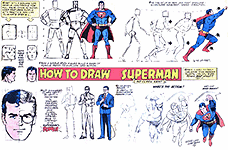|
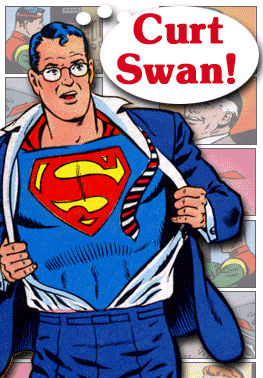 What
can I say about Curt Swan's Superman that hasn't been said
already? What
can I say about Curt Swan's Superman that hasn't been said
already?
For over thirty years -- an
impressive stretch by any standards but a virtual eternity
in comic book terms -- Curt Swan was the mainstay of the
Superman mythos. During his tenure, and with his input,
the vast and wonderful universe of the Silver Age Superman
dawned, peaked and finally faded.
In the course of those three
decades, other artists came and went, grabbing glory then
moving on, while Swan remained steadfast, consistently turning
out story after story of handsome illustrations with a dependability
and dedication to rival Superman's own.
Swan began his association
with the Man of Steel in the early 50's, pencilling issues
of Superboy and Jimmy Olsen. His contributions
to the popular 1955 one-shot Superman 3-D earned
him regular work on the "flagship" titles Action
and Superman. Eventually Swan succeeded Wayne Boring
as the Man of Tomorrow's principal artist, and stayed with
the character from the TV-influenced stories of the 50's
through the "super-everything" 60's and the soap-opera
"relevancy" of the 70's right up to the Multiverse-shaking
"Crisis" of 1986. Along the way he teamed with
legendary creators from Edmund Hamilton, Jerry Seigel and
Otto Binder to Cary Bates, Elliot S! Maggin and Alan Moore.
Like a comics industry version
of Norman Rockwell, Swan was a master at illustrating an
idyllic America. His characters were good-looking in a pleasant
sort of way, not so much like movie stars or supermodels
as the wholesome, clean-cut guy or gal next door. He prided
himself on his ability to draw "real" people in
realistic settings, but he also had fun creating various
life forms, architectures and fashions for scores of alien
worlds.
Swan could choreograph a fight scene with
the best of them, but his real strength lay in his depictions
of human emotion. His predecessor Wayne Boring drew a huge
and powerfully-built Man of Steel, brimming over with power
but limited to a mere handful of stock facial expressions:
open-mouthed shock, clench-jawed solemnity (easily the most
used) and the ubiquitous grin and wink. In contrast, Swan's
Superman (and Jimmy, and Lois, and Luthor...) had an endless
repertoire of facial expressions; joy, rage, desperation,
deviousness, confusion, panic, contentment, jealousy, wistfulness,
adoration, annoyance, each depicted with a subtle skill
that made captions superfluous. There was no need to tell
us when Superman was feeling blue; we could see it in his
face.
The switch to a more human
Superman was decided by group editor Mort Weisinger. "Mort
wanted the drawing to be less cartoony and more illustrative,"
Curt later explained. Even so, the editor had issues with
Curt's use of lines to show emotion on the characters' faces.
"He thought it made Superman look too old," wrote
Swan. I think I finally got through to him by pointing out
that even a baby, when it's angry or crying, has lines on
its face."
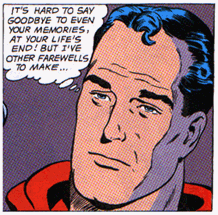 Swan's accent on emotion suited the Silver Age Superman,
as the books took on operatic overtones of tragedy and pathos
and indulged in fond sentiment for an ever-expanding supporting
cast of friends and foes. The Superman of this era may have
been near-invulnerable physically, but emotionally he was
as human as the next guy. He could fall deeply in love and
often pined for his lost world of Krypton. He felt genuine
disappointment over his friend-turned-enemy Lex Luthor,
strong paternal concern for his young cousin Supergirl,
abiding grief for two lost sets of parents, warm affection
for Batman and Robin, and continual frustration in his efforts
to enlarge Kandor.
Swan's accent on emotion suited the Silver Age Superman,
as the books took on operatic overtones of tragedy and pathos
and indulged in fond sentiment for an ever-expanding supporting
cast of friends and foes. The Superman of this era may have
been near-invulnerable physically, but emotionally he was
as human as the next guy. He could fall deeply in love and
often pined for his lost world of Krypton. He felt genuine
disappointment over his friend-turned-enemy Lex Luthor,
strong paternal concern for his young cousin Supergirl,
abiding grief for two lost sets of parents, warm affection
for Batman and Robin, and continual frustration in his efforts
to enlarge Kandor.
By the late 60's, the enormous
Weisinger-era "Superverse" was already being deconstructed
and shrunken. The early 70's saw Superman re-tooled as a more
streamlined character, with a smaller and mainly Earth-bound
supporting cast. In this era, Superman was more likely to
spend his down time in front of Clark Kent's TV set than in
an arctic Fortress full of alien relics, and was more interested
in dating Lois
Lane than playing
"Nightwing" in Kandor. Again, Curt Swan proved
his worth, adapting easily to this new focus on Superman's
humanity. Teamed with inker Murphy Anderson, he produced what
many consider the best artwork of his career.
|
|
CURT SWAN COVER GALLERY (click
to enlarge)
|
|
|
|
|
|
|
|
|
|
|
|
|
|
By the early 80's, however, fans were
getting restless. Swan's long tenure as chief artist
had fostered a comfortable sense of continuity in
the Superman titles, but in the interim, other comic
book characters had stolen the limelight through policies
of innovation and change. In the 70s and early 80s
Batman enjoyed a creative renaissance at the
hands of "hot" new artists like Neal
Adams, Marshall Rogers and Michael Golden, each
of whom re-tooled the Dark Knight to fit their styles.
In Marvel's The New X-Men, writer Chris Claremont
and artists Dave Cockrum and John Byrne took a so-so
team of second-stringers and transformed them into
the company's most popular characters. DC answered
with a re-imagined Teen Titans by Marv Wolfman
and George Perez. In this era of bold creative experimentation,
the steadfast Superman stood out like a sore thumb.
Many fans saw him as a character frozen in the past,
stuck in a rut and essentially irrelevant. Curt Swan's
art was a key factor in this perception. Most readers
were too young to remember a time when Superman wasn't
drawn by Swan, and with their insatiable appetite
for new and more daring art styles, Swan's work was
perceived as old-fashioned and dull.
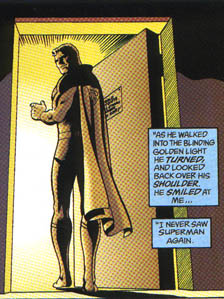 The
writing was on the wall. DC made plans to re-invent
Superman from the ground up following their epic Crisis
on Infinite Earths, eventually entrusting the character's
future to (then) superstar artist/writer John Byrne.
Ironically, during this "lame duck" period
of his Superman career, Swan turned in some of his best
artwork ever, thanks in part to the inspired choice
of Al Williamson as his inker. The
writing was on the wall. DC made plans to re-invent
Superman from the ground up following their epic Crisis
on Infinite Earths, eventually entrusting the character's
future to (then) superstar artist/writer John Byrne.
Ironically, during this "lame duck" period
of his Superman career, Swan turned in some of his best
artwork ever, thanks in part to the inspired choice
of Al Williamson as his inker.
Fittingly, Swan drew the
last story of the "Pre-Crisis" Superman in
1986. Titled "Whatever Happened to the Man of Tomorrow?",
the tale was a magnum opus wrapping up storylines that
had been dangling for close to 30 years. Emotionally,
it was a melodrama on par with the best three-hanky
epics of the 60's, and Swan did a phenomenal job, as
always. As it happened, this "last Superman story"
wasn't exactly Curt's "Swan Song" on the character.
Once the "new and improved" model Superman
was established, Swan was quickly invited back for numerous
special projects (like "The Earth Stealers,"
a one-shot with Byrne and Jerry Ordway) and the occassional
guest page in anniversary issues and the like. But in
every way that counted, Swan had passed the pen to a
new generation of artists, and in 1996, he passed away.
Though often underappreciated
by fans, Swan was a hero to many younger artists, including
fan favorite George Perez, who counted Swan as a major
influence and writer/artist Dan Jurgens, who guided
Superman's adventures throughout the early to mid-90s.
In his later years, Curt was said to be continually
surprised at the number of fans he did have; he had
looked at his work simply as a job, like any other.
That so many people would remember, and cherish, his
work years afterwards always amazed him.
In the end, our pleasure
was all Curt was after. "I get more enjoyment out
of watching a young one's smiling face staring into
a comic book that I drew," he said near the end
of his life, "than I could possibly get out of
all the money, praise and accolades in the world!"
For Curt's sake, I like
to think that on any given day, somewhere in the world
kids are discovering his version of Superman. 'Cause
if they are, you can bet they're smiling. And so is
he.
|
|
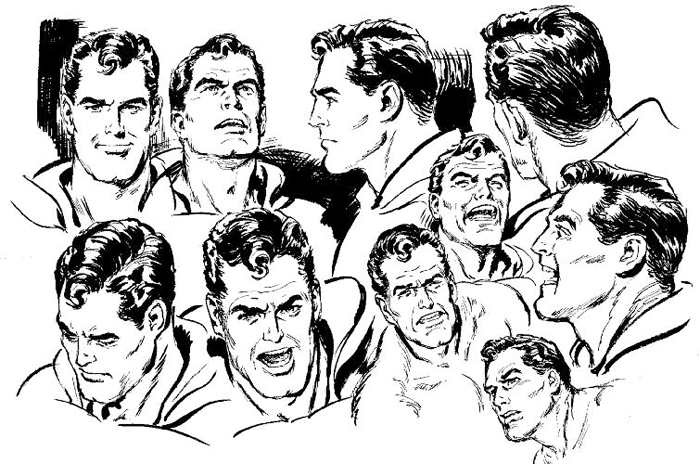
|
 |
|

 What
can I say about Curt Swan's Superman that hasn't been said
already?
What
can I say about Curt Swan's Superman that hasn't been said
already?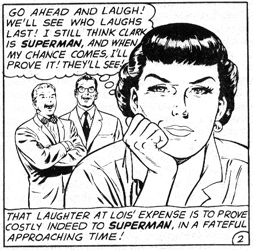
 Swan's accent on emotion suited the Silver Age Superman,
as the books took on operatic overtones of tragedy and pathos
and indulged in fond sentiment for an ever-expanding supporting
cast of friends and foes. The Superman of this era may have
been near-invulnerable physically, but emotionally he was
as human as the next guy. He could fall deeply in love and
often pined for his lost world of Krypton. He felt genuine
disappointment over his friend-turned-enemy Lex Luthor,
strong paternal concern for his young cousin Supergirl,
abiding grief for two lost sets of parents, warm affection
for Batman and Robin, and continual frustration in his efforts
to enlarge Kandor.
Swan's accent on emotion suited the Silver Age Superman,
as the books took on operatic overtones of tragedy and pathos
and indulged in fond sentiment for an ever-expanding supporting
cast of friends and foes. The Superman of this era may have
been near-invulnerable physically, but emotionally he was
as human as the next guy. He could fall deeply in love and
often pined for his lost world of Krypton. He felt genuine
disappointment over his friend-turned-enemy Lex Luthor,
strong paternal concern for his young cousin Supergirl,
abiding grief for two lost sets of parents, warm affection
for Batman and Robin, and continual frustration in his efforts
to enlarge Kandor.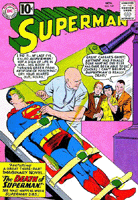
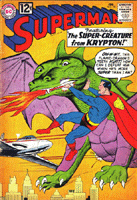
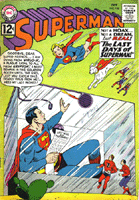
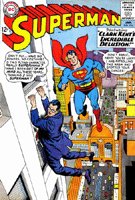
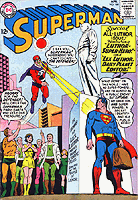
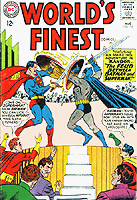
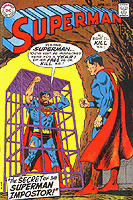
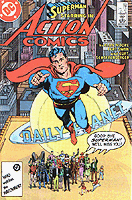
 The
writing was on the wall. DC made plans to re-invent
Superman from the ground up following their epic Crisis
on Infinite Earths, eventually entrusting the character's
future to (then) superstar artist/writer John Byrne.
Ironically, during this "lame duck" period
of his Superman career, Swan turned in some of his best
artwork ever, thanks in part to the inspired choice
of Al Williamson as his inker.
The
writing was on the wall. DC made plans to re-invent
Superman from the ground up following their epic Crisis
on Infinite Earths, eventually entrusting the character's
future to (then) superstar artist/writer John Byrne.
Ironically, during this "lame duck" period
of his Superman career, Swan turned in some of his best
artwork ever, thanks in part to the inspired choice
of Al Williamson as his inker. 